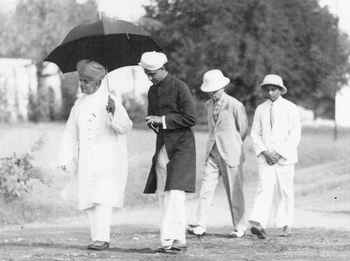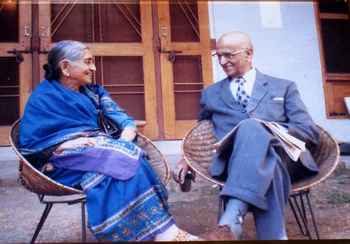Is it a memoir or another book depicting the glory of old Mysore? Is it about the politics and administration of the kingdom of Mysore? It is hard to categorise MA Sreenivasan’s ‘The Last Mysore Pradhan’. I presumed it would be the author’s autobiography when I had started reading it. But the book had much more to offer.
Sreenivasan started his career as a young Mysore Civil Service (M.C.S) officer in 1918. He served as with both Mysore Kingdom and then the Government of British India. He was made a minister (pradhan) in 1943. In 1947, he was invited by the Maharaja of Gwalior to become the vice-president (Dewan) of that state.

Maharaja Nalavadi Krishnaraja Wodeyar visiting Krishna Rajendra Mills with M A Sreenivasan (pic courtesy: Devaki Jain)
He was also closely involved with several industries and had been the chairman of varied companies that ranged from Kolar Gold mines, Air India to several coffee plantations.
The book narrates some memorable administrative experiences in the pre and post independent India.
The initial chapters dwell on the author’s background and education; his lineage, the royal intrigues, the simple joys of growing up in Thiru-Alli-Keni (Triplicane); the joys he experienced on his admission to Central college, marriage and finally clearing the Mysore Civil Service exams. The story then shifts from the traditional brahminical background to the every day life in Mysore kingdom’s administrative offices. From here, the book ceases being just a memoir and provides a peep hole into the administrative life of that period.
Most of our history books describe the Mysore governance during the Wodeyars-British alliance as ‘very progressive’ and also hail it as a ‘glorious time in the history of administration of Mysore’. This can perhaps be best explained through the lives of Mysore civil servants like Sreenivasan who interacted with the people and worked at the grassroots level.
With simple language and wit, he has used anecdotes of mundane administration into a spicy and fascinating story of the then Mysore politics.
Politics in those days was as clean or murky as it is in current times. One can easily relate to his seven decade old accounts of bribery and deceit in the Sivasamudram project or the sandalwood oil exports as if those are tales of our contemporary society.
However, not all the projects during those days were scams; in his lucid style, he explains some good work done by the Mysore Government – be it the low cost housing initiatives (Agraharas), or the innovative dhobi ghat (an idea he borrowed from the bhojanshalas of the Hampi ruins) or the reforms for miners in Kolar.
His time at Kolar Gold Fields is in fact described in great detail. Working thousands of feet below the ground, the Kolar Gold miner’s job was hardly golden. The life of a worker in the mines and the hardships endured, mostly by the Tamil workers in the mines is described in a minute and sensitive manner. He mentions what one Tamil miner told him – “Your Mysore Government man, he gave away his gold to the white man and is now scratching for iron” – frustration and irony rolled into one scathing comment.
Sreenivasan’s honest report of the situation and especially of the steps taken to rectify the conditions brings out the how Mysore civil servants and the Maharaja functioned.

M A Sreenivasan with his wife Singamma (pic courtesy: Devaki Jain)
Sreenivasan was the chairman of the Kolar Gold Fields in an independent India; he has explained how the mines became a hotbed for bitter politics. He also compares the fate of KGF to that of the goose that laid golden eggs.
Some chapters are dedicated to the lifestyle of civil servants of those days. In an era when there were no automobiles yet, horses played a prominent role in commuting. His daughter, Devaki Jain, a noted economist, recalls her childhood memories of her father taking her for a stroll on his horse, after the city inspection rounds with Sir Mirza Ismail.
His narration shows how the administrators on horseback in those days were far more aware of the reality than the current politicians or administrators who zoom off in cars with tinted shades!
The book also highlights the political events in India at that time. The rise of ugly head of communalism during partition while he was Dewan for Gwalior state, his lucky visit to Sabarmati to meet Gandhi the day before he was shot, the politics involved in the merger of princely states, the rushed handover of Independence by Mountbatten all make for fascinating reading.
The Last Mysore Pradhan – The Memoirs of M A Sreenivasan
DroneQuill Publishers, First Dronequill edition 2005
238 pages
From the point of view of an eminent civil servant, Sreenivasan provides a ring-side view to the reader of events that shaped India’s destiny.
From his traditional upbringing in Triplicane to being a Pradhan in the Raj era and later becoming the chairman of several industries, he witnessed and experienced much of the changing times. In his ethnic Mysore Peta (turban) and English dress code, Sreenivasan maintained a perfect balance between his traditional upbringing and the western style of administration. Perhaps this is best brought out in the episode where Sreenivasan quotes from the Gita to advice an Englishman on the nuances of playing better golf!
Sreenivasan was well read, and knowledgeable about diverse subjects. How did the civil servants of those days accomplish so much in such diverse fields? "In the pre-automobile days, the velocity of time was slow", explains M A S Rajan, the eldest son of Sreenivasan. "So the civil servants had a lot of time on hand after work. Many of them were thus excelled in diverse fields. His colleague Masti Venkatesha Iyengar, for example, was an accomplished writer after retiring."
The book is a reflection of a fast-changing India of the 20th century. Sit by the window, stretch your legs and enjoy the book. It will give you a vivid view of pre-independent Mysore and its civil administration. ⊕
As i remember, Late M.A. Sreenivsan had written a Book which was titled may be as The Raj, Maharajas And Me and last Mysore Pradhan was a chapter in that book .(Unfortunately some one borrowed my copy of the book with signature by Late MAS and never returned). Can you clarify whether you are referring to some other book or the same one i have named above ?
Also you have failed to tell why he calls himself as Last Mysore Pradhan and his forbears role in vanquishing Tipu and helping Wadiyars! why ? Do you think in this Post Independent era of British Bashing and hailing Tipu as a freedom fighter it no longer sounds proper ? Late MAS did not mince words even when he spoke on AIR about this!
It is the same book. This version is published by Dronquill. It was previously published by Ravi Dayal as ‘The Raj, Maharajas and Me’.
A review does not give away all the details so that there is some curiosity left for the reader.
Am glad you know about MAS. But the article is a simple book review highlighting the civil administration of those days.